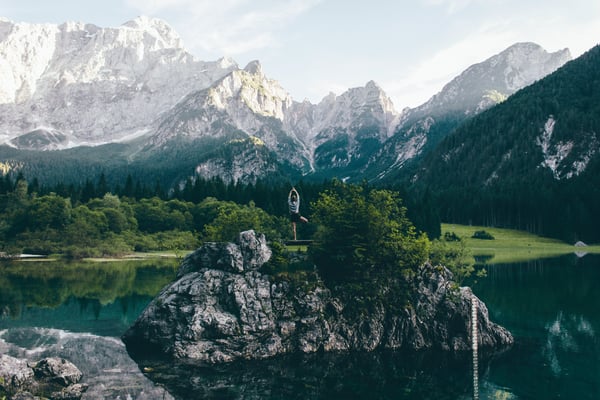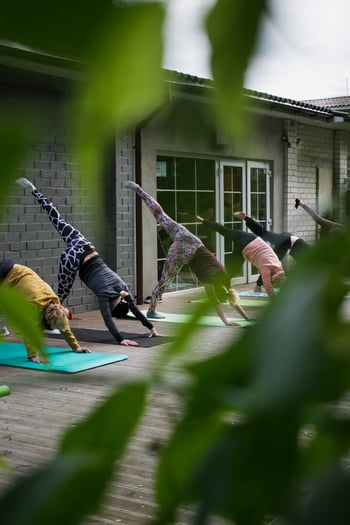How to Plan a Retreat: Your Step-by-Step Guide

At first glance, it seems like anyone with enough motivation could figure out how to plan a retreat. You just get some people together, go somewhere cool, and do some fun stuff, right?
To the contrary, it actually takes a lot of organization, research, and preparation to plan a retreat that doesn’t just run smoothly, but makes money and gets those coveted five-star reviews.
In fact, a poorly planned retreat can be not only embarrassing but downright disastrous in the wrong context. So before you assume you can easily figure out how to plan a retreat, you need to know what you’re getting into. It takes more than some great photos of smiling faces and everyone having a great time to be successful.
So to help you get started, here is a simple step-by-step guide for how to plan a retreat that enlightens people.
Step #1 - Identify your purpose and intention

First and foremost, you need to know why you want to plan a retreat.
Does your retreat center offer something unique like wellness programming, cultural attractions, or nearby excursions? If your center already has a focal theme or specializes in a certain practice, this can make it easier for you to plan a retreat.
It may be tempting to create a retreat that appeals to everyone and cast a wide net. However, the more specific you are, the easier it will be for you to connect with people looking for a unique experience like yours. It will make it a lot easier for them to imagine themselves at your retreat center.
Are you planning to gather a group at a remote center for a week of adventuring? Or, do you offer yoga somewhere by the beach with incredible scenery? Starting with a clear vision can make planning your retreat easier. It will help you build the perfect itinerary, promote to the right people, and curate a fantastic program that inspires people.
Now, before you get started, it’s important to ask yourself the following questions:
- What is the central theme of your retreat? Are you looking to focus more on cleansing and wellness, yoga and dance, creativity and art, emotional healing, women’s empowerment, etc.
- How will you utilize your retreat center? Do you want to set aside the whole center for your retreat, or will you have other guests on site simultaneously?
- How many people do you want to have at your retreat, and what type of demographic? A 10-person retreat requires very different logistics versus a 30-person retreat, and a group of women in their 20’s has very different needs from a group of retirees.
- As the leader(s), what services, classes, or types of programming do you want to offer? Do you have a space for yoga? Do you want to offer participants access to different service providers, like massage or other healing modalities? Do you offer plant medicine treatments? All of these play a factor in how to plan a retreat that works for your center.
- When do you want to host your retreat? Planning ahead can increase your options and give participants more time to prepare. Do you want to offer a short weekend escape, or a week-long immersion?
Once you have your answers, let this clarity be your guide for successfully navigating and organizing your retreat. Here is what your building framework will look like:
Retreat Theme
Center logistics (private retreat or public)
How many people, demographic
Services, classes, programming needs
Ideal dates and length:
Step #2 - Map out your lodging options
Now that you have a general idea of your retreat theme and target demographics, map out what types of lodging will be best suited for your retreat participants. Here are some of the important questions you should be asking yourself:
- What types of rooms are available at your facility? Do you offer shared rooms, dormitory lodging, or suites? If you mostly offer single rooms, do you have the ability to make changes in order to accommodate more people for some programs? Your retreat participants might need single rooms if you offer something more sensitive like a plant medicine retreat. Do you know how to accommodate those needs?
- What is the baseline cost for each room? Make sure you have a good understanding of what your basic costs are for each room. How much do you need to spend on supplies for each guests? What is the cost of cleaning and laundry? This will help inform you how to price your retreat packages.
- How will you handle roommate requests? If you plan to offer doubles and triples, how will you assign and track single travelers who wish to share a room? Will you offer gender-specific spaces, or mixed? This is often dependent on the theme of the retreat.
- Will you need to adjust any daily schedules or routines to accommodate the retreat? You may need to alter your typical meal times, cleaning schedules, or space usage while your retreat is taking place.
Take stock of the rooms you have to see how they can be used to fit the retreat idea you have planned. Offering attractive room options is a critical part of giving guests a great experience and planning a successful retreat.
Step #3 - Decide how you want to price your retreat
Now that you have a retreat theme, understand your baseline costs, and know who you want to host, it’s time to create your retreat packages.
Make sure to consider any additional costs, taxes, and gratuities in advance before you even look at add-ons to offer participants. Add-ons can be anything like excursions, spa services, ceremonies, or special sessions with guest teachers, anything that can help add value to the guest experience.
Note: Some of the most successful retreats offer all-inclusive packages where the room, meals, the majority of group excursions, and other activities are already included. Your participants would only need to pay for added services like a spa or massage along with snacks.
Use a spreadsheet to map out all of your rooming options. Typically, single rooms cost more per person than doubles, doubles cost more than dorm-style, and so on. Determine the base cost for each room along with the cost for you to prepare them.
Once you know your numbers, decide on your mark up to make the retreat profitable for you to run. Make sure you don't forget to consider additional overhead costs such as payment for facilitators, healers, and other key contributors who will make the retreat memorable.
Step #4 - Find out if people are interested
When planning a retreat, there will inevitably be some anxious moments along the way.
Will anyone want to come to my location? Are people willing to pay this much? Will people prefer a shorter retreat or an extended experience?
The best way to get some answers is to ask.
Reach out to a small group of your clients, students, and even friends who might be the right fit for your retreat. Tell them about your location, the cost, and the dates. Ask them if that sounds like something they’d be interested in or if they have some concerns.
Is the price too high? Are they able to take a week off during that time of year? Is it too close to the holidays? Hearing this feedback before you invest a lot of time and money will save you so many headaches.
If you need to make changes to accommodate this feedback, do it. And sooner rather than later.
Step #5 - Sort out your logistics and start marketing!

It’s time to finish preparing your space, find the right teachers, and get your staff sorted out.
You’ve done your homework and understand how to plan a retreat. You’re confident that you can deliver an enlightening and fulfilling experience to participants. It is time to start marketing, get those registrations, and fill your spots!
Depending on your location, you may have other logistics to consider such as airport transportation, Visa requirements, participant gifts, or other add-ons.
When it comes to marketing, there are so many avenues open to you:
- Share with your email lists - If you have past guests or clients who might be the right fit for your retreat, share it with them. Share some of the highlights and benefits your retreat will offer while making sure they know you appreciate them for being a part of your inner circle.
- Post on social media - Create posts for your retreat and share with your followers as well as other related groups who could be the right fit for your retreat. Make sure to engage with people in the comments to build on the connection!
- Run social media ads - Set aside a small budget to promote your retreat to a wider audience. This can be especially effective in the last few weeks before your retreat as many people are still making last minute travel decisions!
- Connect with people in your space - Reach out directly to people in your network who are apart of your space to see if they would be willing to promote your retreat. Share the type of experience you are looking to give and see if they have any feedback or advice for you too.
Once you have done most of the leg work for how to plan a retreat, there are plenty of ways to promote it and find participants!
Final Thoughts: How to plan a retreat
With the right approach, planning a retreat doesn't need to be as complicated as it seems. Now, you will be much more prepared than some of the other retreat leaders out there!
While it can be difficult to run a successful retreat, the right approach and plan can make all the difference. As you plan, make sure to identify your purpose and intention for hosting a retreat, map out your lodging options, lock down your costs, do some research, and then start marketing.
Now you know exactly how to plan a retreat. Good luck on your journey and best wishes for a successful adventure!




